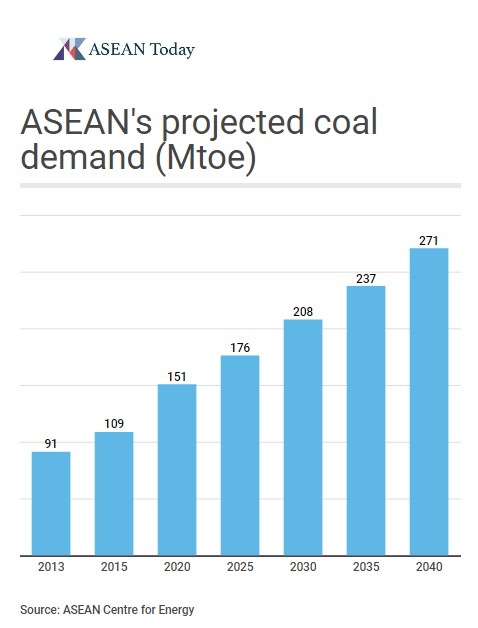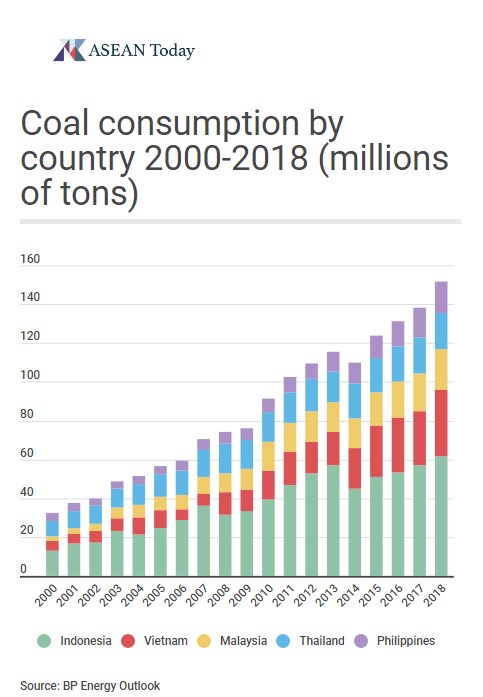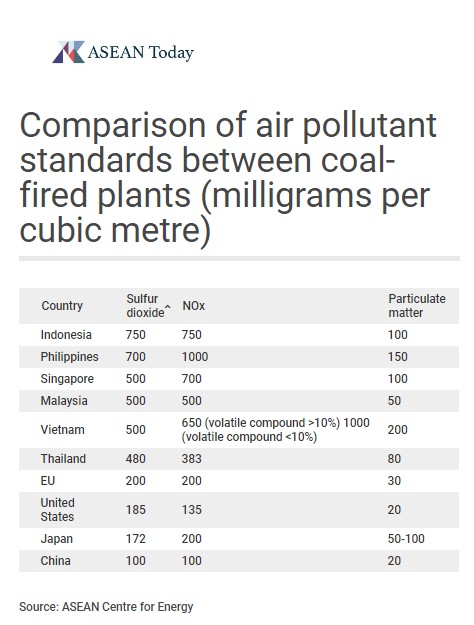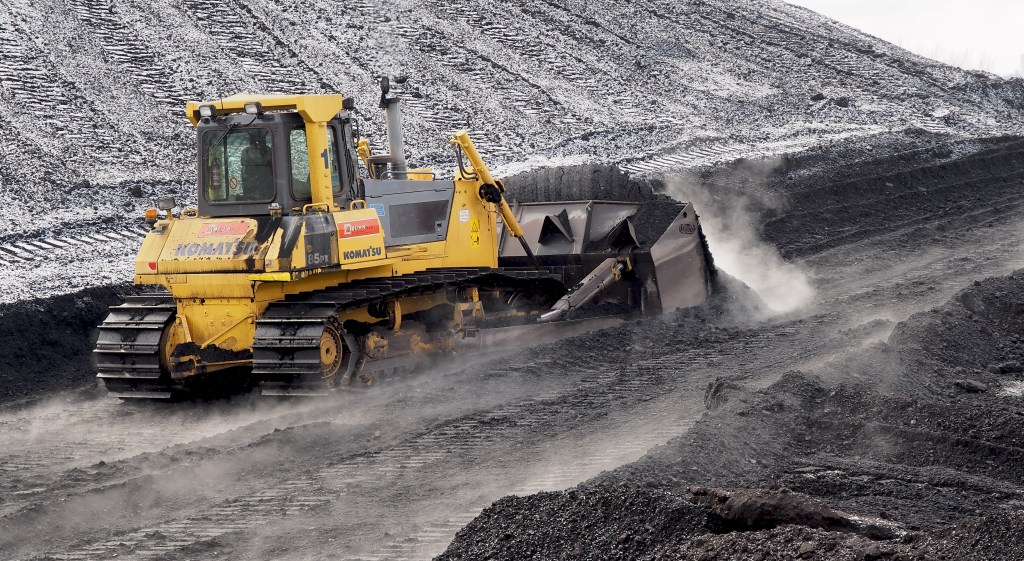Universal electricity access is a key pillar of ASEAN’s development goals. The regional bloc has committed to providing every citizen with an electricity supply by the early 2030s. To achieve this end, the region will need to increase its power capabilities by some 60% by 2040.
To quench the thirst for power, Wood Mackenzie, an energy research company, estimated in its September report that ASEAN nations would need to invest US$17 billion a year.

Coal is king—for now
ASEAN currently relies on natural gas for the bulk of its energy needs. The bloc receives 42% of its energy from liquified natural gas sources. However, this is set to change.
To meet a rapidly rising energy demand, ASEAN is turning to coal. Coal-fired power plants offer a cheap, readily available source of energy. Under the ASEAN Plan of Action for Energy Cooperation (APAEC) 2016-2025, coal is expected to meet 40% of new energy demands until 2040. An increasing proportion of ASEAN’s energy imports will also come from coal. The Japanese energy industry, a major importer to the region, has increased its reliance on coal since the Fukushima nuclear disaster.
This increased dependence on coal puts ASEAN at a crossroads. At present, ASEAN cannot afford to rely on alternate, cleaner energy sources. The cost of wind and solar energy is approximately 29% higher than coal-fired power in the region. However, embracing coal comes with its own cost. If all of ASEAN’s planned coal projects are carried to fruition by 2030, an estimated 70,000 citizens will die each year as a result of medical complications caused by coal-fired plant emissions.
ASEAN has already made its decision. At the 2018 Ministers on Energy Meeting, the ASEAN+3 (China, Japan and Korea) renewed ASEAN’s commitment to coal-fired power. Coal is expected to overtake natural gas as the region’s dominant energy source by 2035.
Wood Mackenzie estimates that solar and wind power will have to wait until the 2040s to lead the region’s power capacity. ASEAN nations will wait until the cost of renewables can compete with coal before making the transition.

ASEAN has an obligation to mitigate the environmental impacts of coal-fired power plants
ASEAN’s relationship with coal over the next two decades cannot resemble that of the last two. With ASEAN’s energy portfolio wedded to coal, it must take steps to reduce pollution from coal-fired plants and mitigate emissions to protect citizens’ rights to clean air and a safe living environment.
Currently, 86% of ASEAN’s coal-fired power plants consist of what is known as “subcritical” units. These are inefficient, high-polluting, outdated units that do not incorporate the carbon-capture and storage technologies of more modern plants. As ASEAN expands its coal capabilities, it will need to increase the proportion of “supercritical” (SC), “ultrasupercritical” (USC), and “advanced ultrasupercritical” (AUSC) plants in its energy portfolio. These high-efficiency low-emission (HELE) plants burn coal at much higher temperatures and pressures to reduce pollutants and produce power more efficiently than older subcritical units.
As of 2018, Malaysia was the only ASEAN nation with HELE powerplants. It has also committed to using mainly USC units in new developments. Thailand’s recently added energy capacity has also been exclusively limited to SC units.
It is through the adoption of HELE units that has allowed China, the US, Japan and the EU to pursue cleaner air policies while maintaining the inclusion of coal in their energy portfolios.

Not only do HELE units reduce emissions, they are also more financially viable in the long run. Their increased efficiency means less coal is required to produce the same volume of power, reducing running costs. Subcritical units incur running costs two to three times higher than supercritical plants.
Not everyone is committed to cleaner coal
While Malaysia and Thailand have taken steps towards incorporating HELE coal technologies, other nations have been reluctant to make the transition. Dr Ian Barnes of the International Energy Agency (IEA) said the Vietnamese government will only develop AUSC units “when plants are retired and additional power is needed from 2035 onwards”. He added that Indonesia remains “heavily biased” towards subcritical and SC units.
This poses a problem for a region already battling the effects of climate change and deteriorating air quality. Indonesia and Vietnam will account for 60% of Southeast Asia’s total power demand by 2040.
An October report from the ASEAN Centre for Energy outlined a vision to “fully implement” clean coal use and “accelerate efforts” to reduce pollutants but has little support from the bloc’s two largest coal users.

Photo: Petar Milosevic
Even when the Indonesian government has made concrete commitments to reducing emissions, it has failed to live up to them. For example, the government announced plans to source 23% of its energy from renewables by 2025. However, it maintains subsidies on coal and has done little to reduce the costs of wind and solar power, prompting Moody’s to question Indonesia’s ability to meet its target. On the matter of clean coal, it has not even made as nominal a gesture as setting a target or implementation timeline.
Increased collaboration will be key moving forward
The establishment of a new regional Clean Coal Centre would help ASEAN transition to cleaner coal technologies and improve its air quality. A regional body would help facilitate research and development and encourage technology sharing, effectively giving developing countries a leg up in the development of cleaner coal technologies.
The introduction regional emissions standards as part of the APAEC 2015-2025 to push individual nations to upgrade and retrofit coal-fired plants with HELE technologies would also help ensure the region’s energy infrastructure developments do not induce a public health and environmental crisis.
Finally, the most recent ASEAN Centre for Energy report recommended regional coal power plants carry out environmental impact assessments to explore ways to reduce their environmental impact. Governments could easily leverage existing financing schemes to incentivize these assessments. Making coal subsidies contingent on coal companies undertaking environmental impact assessments would push the private sector to consider the role it plays in the deterioration of regional air quality. Governments can even push financial institutions to fund cleaner coal options over inefficient, high-polluting units.
The emissions debate is often framed as a binary choice. Developing nations have to choose between pursuing bolstering their energy security and protecting the environment. The reality is far more nuanced. With a strong political will, ASEAN can pursue its energy ambitions, while upholding efforts to mitigate their environmental impact. Coal will always be a dirty industry, but until renewable energy sources are economically viable, ASEAN governments should seize any opportunity to clean up coal operations.




